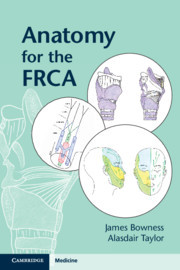Anatomy for the FRCA
Langue : Anglais
Auteurs : Bowness James, Taylor Alasdair

This practical, comprehensive anatomy book arms FRCA candidates with detailed, robust anatomical knowledge via a question-based approach.
Anatomy questions are asked in all parts of the FRCA examinations, and for many trainees it is a particularly daunting part of the exams. This important new book provides a comprehensive, exam-orientated clinical anatomy book for anaesthetists preparing for all parts of the FRCA. It covers all body regions, relating underlying anatomy to practical procedures and anatomical principles, spanning the breadth of the curriculum and comprising exam-style questions: a chapter of SAQ questions, one of OSCE stations, one of SOE questions and one of MCQs. The text is highly illustrated in full colour with ultrasound images, diagrams and photographs of cadaveric material and models. This is the first anatomy book specifically orientated for the FRCA exam, making it an essential resource for anaesthetists preparing for all parts of the FRCA examination.
Part I. Question Papers: 1. SAQ Exam; 2. OSCE exam; 3. SOE exams; 4. MCQ exam; Part II. SAQs 1–12 (Answers): 5. Base of skull and brain herniation; 2. Brachial plexus and axillary block; 3. Bronchial tree and aspiration pneumonia; 4. Epidural space and Epidural; 5. Femoral triangle and fascia iliaca block; 6. Internal jugular vein and cannulation; 7. Intercostal space and chest drain/procedures; 8. Lumbar plexus and lumbar plexus block; 9. Oesophagus; 10. Pituitary gland and transsphenoidal approach; 11. Popliteal fossa and block; 12. Trachea and tracheostomy; Part III. OSCE Stations 1–18 (Answers): 1. Ankle block; 2. Base of skull, foramina and extradural haematoma; 3. Blood supply of the upper limb and Allen's test; 4. Brachial plexus and Supra-/Infraclavicular Blocks; 5. Circle of Willis; 6. Vagus Nerve (CN 10); 7. Coronary circulation; 8. Diaphragm; 9. Dural venous sinuses and cavernous sinus thrombosis; 10. Inguinal regional and hernia; 11. Larynx; 12. The liver and portal venous system; 13. Nose and paranasal air sinuses; 14. Paravertebral space and block; 15. Peripheral nerves of the upper limb; 16. Rectus abdominis, sheath and rectus sheath block; 17. Ribs and ventilation; 18. Vertebrae and spinal ligaments; Part IV. SOEs 1–3 (Answers): 1a. Cervical plexus and carotid endarterectomy; 1b. Anterolateral abdominal wall and TAP block; 1c. Brachial plexus and interscalene block; 1d. Spinal cord blood supply and tracts; 2a. Trigeminal nerve (CN 5) and trigeminal neuralgia; 2b. Pleura and interpleural block; 2c. Cubital fossa and inadvertent intraArterial injection; 2d. Sacrum and caudal block; 3a. Scalp block; 3b. Fetal circulation; 3c. Blood supply of the lower limb and intraosseous access; 3d. Orbit; Part V. MCQs 1–60 (Answers).
James Bowness has been involved in teaching anatomy for many years at St Andrews University for undergraduate medical students, the Royal College of Surgeons of Edinburgh for MRCS candidates, and he also developed the 'Anatomy for the FRCA' course for FRCA candidates alongside Alasdair Taylor.
Alasdair Taylor has worked in both emergency medicine and anaesthesia. He spent a year living and working as an anaesthetist in Ethiopia, where his work mainly comprised of clinical teaching and service development. He has since returned to the UK and is completing a fellowship in regional anaesthesia. He has developed the 'Anatomy for the FRCA' course alongside James Bowness.
Alasdair Taylor has worked in both emergency medicine and anaesthesia. He spent a year living and working as an anaesthetist in Ethiopia, where his work mainly comprised of clinical teaching and service development. He has since returned to the UK and is completing a fellowship in regional anaesthesia. He has developed the 'Anatomy for the FRCA' course alongside James Bowness.
Date de parution : 07-2019
Ouvrage de 180 p.
15.5x23.4 cm
Disponible chez l'éditeur (délai d'approvisionnement : 14 jours).
Prix indicatif 36,76 €
Ajouter au panier
© 2024 LAVOISIER S.A.S.



